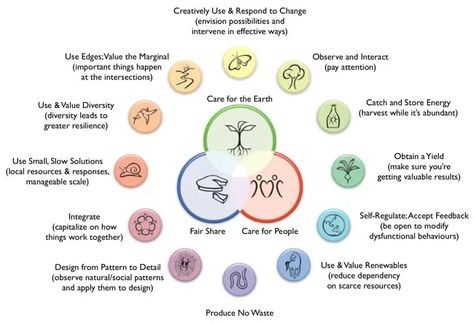Date of the last update: 01.06.2022
In part I of this article, we started to see what inspired Bill Mollison and David Holmgren to originate the permaculture design concept. In this 2nd part, we’ll look at how it relates to sustainability and what it brings to the world.
Table of Contents:
You can read this article in 3 minutes.
Part I: Designed solutions for a changing new world – Part I
New food production systems – Permaculture
So, with all of this in mind, Mollison and Holmgren devised these new food-producing systems and called it Permaculture by joining the words’ permanence’ and ‘culture’. The word ‘culture’ was a contraction of agri-culture since no stable human society can exist without a sustainable and resilient agricultural system. Later on, though, they realized that dealing only with our food production system was not sufficient to create a sustainable society. Hence, the ‘culture’ part started to mean culture in general, since we’ll need to transform our actual culture (both personal and societal as well as ‘the agri’ part) to survive all the challenges we are going through. So, Permaculture became a holistic ecological design system to design sustainable human settlements that are highly self-reliant in all they need to be viable, without harming their environment, as shown by the Permaculture Flower. Its design tools, derived by deeply observing how natural ecosystems work and how successful ancient societies were at adapting to their environment along with several other influences, can be applied to pretty much any domain of human life.

Permaculture and sustainability
So, how does Permaculture Design relate to sustainability? As we have seen, the Permaculture Design concept was conceived a little earlier than the concept of sustainability started to gain ground. From its very beginnings, Permaculture embraced a systemic view of how the world works, making it capable of generating concrete designed solutions. If we think about the definition of sustainability, however: “satisfying the needs of the actual generations must allow for future generations to satisfy their own needs” although desirable, it has a problem in its formulation because it doesn’t define what needs can be satisfied sustainably and which cannot, and until this is clear we’ll have no way of achieving sustainability. Also, the concept of sustainability, per se, doesn’t tell us what to do to be sustainable or even decide when we have achieved sustainability. Finally, in the last few years, we have realized that sustainability is only a part of a continuum that goes from degeneration (that is what most modern human activities produce) to regeneration (that is what nature actually does), so if we are serious about achieving a better human permanence in this world, without affecting those who are still to be born but also countless non-human creatures and species, we have to make sure that we move towards creating regenerative and resilient human systems.
But how? Well, Permaculture teaches us that this can be achieved by conscious ecological design with the guidance of some explicit ethic principles and a certain number of ecological design principles*. We need a way that allows us to make the right decisions unambiguously. The three ethics of Permaculture: Earth Care, People Care and Fair Share do precisely that! Each time we need to make a wise decision, we can filter our ideas by asking ourselves if what we want to do takes care of the Earth, of the People and produces a surplus that can be redistributed fairly in order to take care of the Earth and the People. We can ask this question at any level of human activity.
On the other hand, the permaculture design principles help us make design decisions on how to do things “on the ground” by using system thinking. They are universal in that they can be applied to pretty much anything (from fruit growing to life design, from house design to hydrological design, etc.), what changes, is how they are used according to the cultural or climate context (e.g., it is not the same producing food in cold climates areas than in the Mediterranean or tropical regions, the same goes for housing, etc.).

Permaculture and you
So what does all this have to do with you? Well, you live on this planet as I do, and we’ll all be subject to the same systemic crisis that I mentioned at the very beginning of this article and, since I am sure you are wondering what you can do about it, Permaculture offers an excellent framework for positive action wherever you are. Making changes in this world is difficult, however, especially if you feel that the social context around you does not support the innovation that is needed. Permaculture helps with this by being a vibrant worldwide movement of people who recognize themselves in the three ethics and use its design principles to apply them to their life situations. So, more and more, you can find people near you who have embraced this action-oriented philosophy of life and get together to avoid feeling isolated.
In Permaculture we like to say that we humans are all designers. By using permaculture design, we can do much better designs that always consider our only home, the Earth, our fellow humans, and the rest of living beings, on which very existence we depend.
*There are several versions of the permaculture design principles out there. Both Bill Mollison and David Holmgren have proposed their own sets of 10-12 design principles

